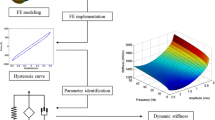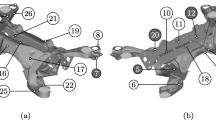Abstract
This paper presents a formulation for incorporating nonlinear viscoelastic bushing elements into multibody systems. The formulation is based on the assumption that the relaxation function can be expressed as a sum of functions which are nonlinear in deformation and exponentially decreasing in time. These forces can represent elastomeric mounts or bushings in automotive suspension systems. The numerical implementation of the nonlinear viscoelastic bushing model into a general purpose rigid multibody dynamics code is described, and an extension of the formulation is also presented wherein component flexibility is included. Model validation was performed by comparing experimental data to simulation results obtained using the nonlinear viscoelastic model and a nonlinear elastic model. The experimental data were obtained at the Center's facilities by testing an automotive lower control arm/bushing system, subjected to a simulated road load event. The comparison demonstrates the better load prediction capability of the viscoelastic bushing model compared to the conventional model.
Similar content being viewed by others
References
ABAQUS: User's Manual, Habbitt, Karlsson and Sorensen, Inc., Pawtucket, Rhode Island
Shabana, A. 1989: Dynamics of Multibody Systems. Wiley
ADAMS: (Automatic Dynamic Analysis of Mechanical Systems) Reference Manual, Mechanical Dynamics, Inc., Ann Arbor, Michigan
Ambrosio, J.; Nikravesh, P. E. 1992: Elasto-plastic deformations in multibody dynamics. Nonlinear Dynamics. 3: 85–104
Bagley, R.; Torvik, P. 1985: Fractional calculus in the transient analysis of viscoelastically damped structures. AIAA Journal. 23: 918–925
Banerjee, A. K. 1993: Block-diagonal equations for multibody elastodynamics with geometric stiffness and constraints. Journal of Guidance, Control, and Dynamics. 16: 1092–1100
Bayo, E.; Avello, A. 1994: Singularity-free augmented Lagrangian algorithms for constrained multibody dynamics. Nonlinear Dynamics. 5: 209–231
Bayo, E.; Ledesma, R. 1994: Augmented Lagrangian and projection methods for constrained multibody dynamics. Proceedings of the 23rd ASME Biennial Mechanisms Conference, Design Engineering Division. DE 72: 237–247
Boutaghou, Z.; Erdman, A.; Stolarski, H. 1992: Dynamics of flexible beams and plates in large overall motions. ASME Journal of Applied Mechanics. 59: 991–999
Gaul, L.; Chen, C. 1993: Modeling of viscoelastic elastomer mounts in multibody systems. In: Schiehlen, W. (ed). Advanced Multibody System Dynamics, pp. 257–276. Kluwer Academic Publishers
Golla, D.; Hughes, P. 1985: Dynamics of viscoelastic structures—a time domain finite element formulation. ASME Journal of Applied Mechanics. 52: 897–906
Holzlohner, U. 1974: A finite element analysis for time-dependent problems. International Journal for Numerical Methods in Engineering. 8: 55–69
Johnson, C.; Kienholz, D. 1982: Finite element prediction of dam** in structures with constrained viscoelastically damped structures. AIAA Journal. 20: 1284–1290
Morman, K.; Nagtegaal, J. 1983: Finite element analysis of sinusoidal small-amplitude vibrations in deformed viscoelastic solids, part 1: theoretical development. International Journal for Numerical Methods in Engineering. 19: 1079–1103
Park, K.; Chiou, J. 1993: Discrete momentum-conserving explicit algorithm for rigid body dynamic analysis. International Journal for Numerical Methods in Engineering. 36: 1071–1083
Pipkin, A.; Rogers, T. 1968: A non-linear integral representation for viscoelastic behavior. Journal of Mechanics and Physics of Solids. 16: 59–72
Ryu, J.; Kim, S. 1994: General approach to stress stiffening effects on flexible multibody dynamic systems. Mechanics of Structures and Machines. 22: 157–180
Yamada, Y.; Takabatake, H.; Sato, T. 1974: Effect of time-dependent material properties on dynamic response. International Journal for Numerical Methods in Engineering. 8: 403–414
Unda, J.; Garcia de Jalon, J.; Losantos, F.; Esperantza, R. 1987: A comparative study on some different formulations of the dynamic equations of constrained mechanical systems. ASME Journal of Mechanisms, Transmissions and Automation in Design. 109: 466–474
**e, M.; Amirouche, F. M. L. 1994: Treatment of creep and nonlinearities in flexible multibody dynamics. AIAA Journal. 32: 190–197
Wallrapp, O.; Schwertassek, R. 1991: Representation of geometric stiffening in multibody system simulation. International Journal for Numerical Methods in Engineering. 32: 1833–1850
**e, K.; Roystre, L.; Ciskowski, R. 1989: A boundary element method formulation for fractional operator modeled viscoelastodynamic structures. In: Advances in Boundary Elements, Vol. 3, Stress Analysis, pp. 55–64. Computational Mechanics Publications
Yi, S.; Hilton, H. 1994: Dynamic finite element analysis of viscoelastic composite plates in the time domain. International Journal for Numerical Methods in Engineering. 37: 4081–4096
Author information
Authors and Affiliations
Additional information
Communicated by S. N. Atluri, 9 October 1995
Rights and permissions
About this article
Cite this article
Ledesma, R., Ma, Z.D., Hulbert, G. et al. A nonlinear viscoelastic bushing element in multibody dynamics. Computational Mechanics 17, 287–296 (1996). https://doi.org/10.1007/BF00368551
Issue Date:
DOI: https://doi.org/10.1007/BF00368551




